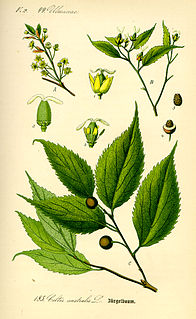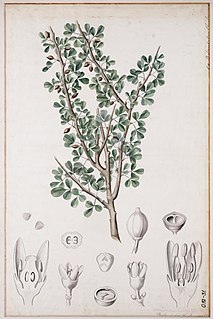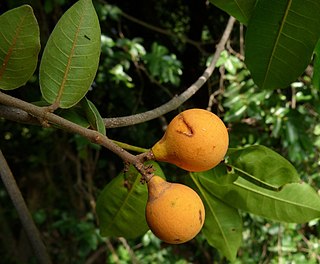
Hyphaene thebaica, with common names doum palm and gingerbread tree, is a type of palm tree with edible oval fruit. It is a native to the Arabian Peninsula and also to the northern half and western part of Africa where it is widely distributed and tends to grow in places where groundwater is present.

Ricinodendron is a plant genus in the family Euphorbiaceae first described as a genus in 1864. It includes only one known species, Ricinodendron heudelotii, native to tropical Africa from Senegal + Liberia east to Sudan and Tanzania and south to Mozambique and Angola. It produces an economically important oilseed. The tree is known as munguella (Angola), njangsa (Cameroon), bofeko (Zaire), wama (Ghana), okhuen (Nigeria), kishongo (Uganda), akpi, djansang, essang, ezezang and njasang. Two varieties of the tree species are recognized R. heudelotii var. heudelotii in Ghana and R. heudelotii var. africanum in Nigeria and westwards.

Celtis australis, commonly known as the European nettle tree, Mediterranean hackberry, lote tree, or honeyberry, is a deciduous tree native to Southern Europe, North Africa, and Asia Minor. The tree was introduced to England in 1796.

Avicennia marina, commonly known as grey mangrove or white mangrove, is a species of mangrove tree classified in the plant family Acanthaceae. As with other mangroves, it occurs in the intertidal zones of estuarine areas.

Faidherbia is a genus of leguminous plants containing one species, Faidherbia albida, which was formerly widely included in the genus Acacia as Acacia albida. The species is native to Africa and the Middle East and has also been introduced to Pakistan and India. Common names include apple-ring acacia, and winter thorn. The South African name is ana tree.

Commiphora gileadensis, the Arabian balsam tree, is a shrub species in the genus Commiphora growing in Saudi Arabia, Yemen, southern Oman, Sudan and in southeast Egypt where it may have been introduced. Other common names for the plant include balm of Gilead and Mecca myrrh, but this is due to historical confusion between several plants and the historically important expensive perfumes and drugs obtained from them.

Barleria prionitis is a shrub in the family Acanthaceae, native to Island and Mainland Southeast Asia, China, the Indian Subcontinent, the Arabian Peninsula and northeastern Africa. It is widely spread as an ornamental and weed, occurring in naturalised populations around the world. It used not only as an ornamental but also as a hedge and extensively as a component of folk medicines. As a weed it is regarded as problematic in many areas.

Celtis africana, the white stinkwood, is a deciduous tree in the family Cannabaceae. Its habit ranges from a tall tree in forest to a medium-sized tree in bushveld and open country, and a shrub on rocky soil. It occurs in Yemen and over large parts of Africa south of the Sahara. It is a common tree in the south and east of southern Africa, where the odour given off by freshly-cut green timber is similar to that of Ocotea bullata or Black Stinkwood.

Trema orientale is a species of flowering tree in the hemp family, Cannabaceae. It is known by many common names, including charcoal-tree, Indian charcoal-tree, pigeon wood, Oriental trema, and in Hawaii, where it has become naturalized, gunpowder tree, or nalita. It has a near universal distribution in tropical and warm temperate parts of the Old World, with a range extending from South Africa, through the Middle East, the Indian subcontinent and southern China to Southeast Asia and Australia.
Cassia sieberiana, drumstick tree, is a tree in the family Fabaceae native to Africa. It ranges from 10–20 metres in height and has very bright yellow flowers. It is used for multiple medical purposes in Africa and is found in the secondary jungle of a forest.

Breonadia is a monotypic genus of flowering plants in the family Rubiaceae. It was described by Colin Ernest Ridsdale in 1975. The genus contains only one species, viz. Breonadia salicina, which is found in tropical and southern Africa from Mali and Benin east to Ethiopia, south to South Africa, as well as Yemen, Saudi Arabia and Madagascar.

Ficus sur, with the common names Cape fig and broom cluster fig, is a widespread Afrotropical species of cauliflorous fig.

Cadaba farinosa is a 2–8 m (6.6–26.2 ft) high evergreen shrub or small tree that belongs to the caper family. It has simple ovate leaves with entire margins, zygomorphic, spidery, greenish, yellowish, whitish or pinkish flowers, and is covered in powdery hairs or scales, particularly the younger parts. It can be found in a zone from Senegal to India between the desert and the savanna.

Pericopsis laxiflora is a woody deciduous shrub or tree within the Fabaceae family. Sold commercially as satin wood, it is known in some regions as Kulu Kulu, among the Hausa speaking people, it is called Makarfo, the Yorubas call it Ayan and the Igbos call it Abua-Ocha. It is one of three species in the genus Pericopsis genus that occurs in Africa.

Landolphia heudelotii is a climbing shrub or liana that is within the Apocynaceae family, it occurs in the Guinea and Sudan savannahs of West Africa and cultivated for its rubber and edible fruit.
Annickia polycarpa is a small to medium-sized tree found in evergreen forests of West and Central Africa, it is within the Annonaceae family. It is also called the African Yellow wood.

Boscia angustifolia is a shrub or small tree with lanceolate leaves commonly found in the savannah zones of Africa, from Senegal moving eastwards to Sudan. It is part of the Capparaceae family. The plant is also known as the rough-leaved shepherds tree.
Anthonotha macrophylla is a shrub to small understory tree within the Fabaceae family. It is endemic to the rain forest regions of West Africa and it is the most common of species within the Anthonotha genus in Africa.
Sacoglottis gabonensis is a medium to large sized evergreen tree within the Humiriaceae family, it is the only species within the genus, Sacoglottis that is native to Tropical Africa. It occurs in rainforests or on sandy soils of Senegal eastwards to Angola in Central Africa. It is trade locally and known in some countries under the name, Ozouga.

Pentaclethra macrophylla, also known as the African oil bean, tree is a large size tree with long bipinnate compound leaves that is endemic to West and Central Africa. It is within the Fabaceae family. Seeds of the species are prepared and fermented to make Ugba, a soup condiment in Nigeria.
















